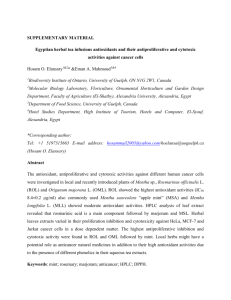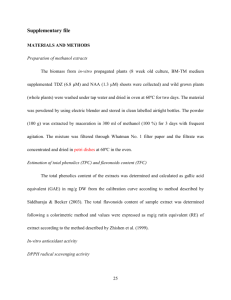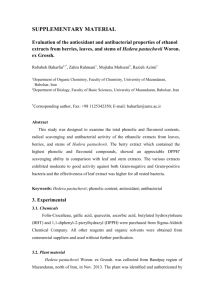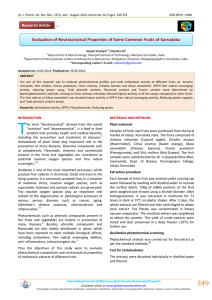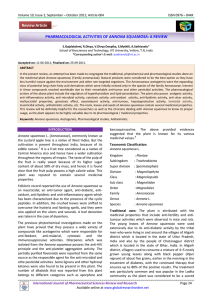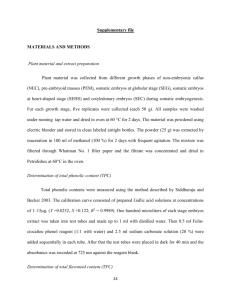Document 13310188
advertisement
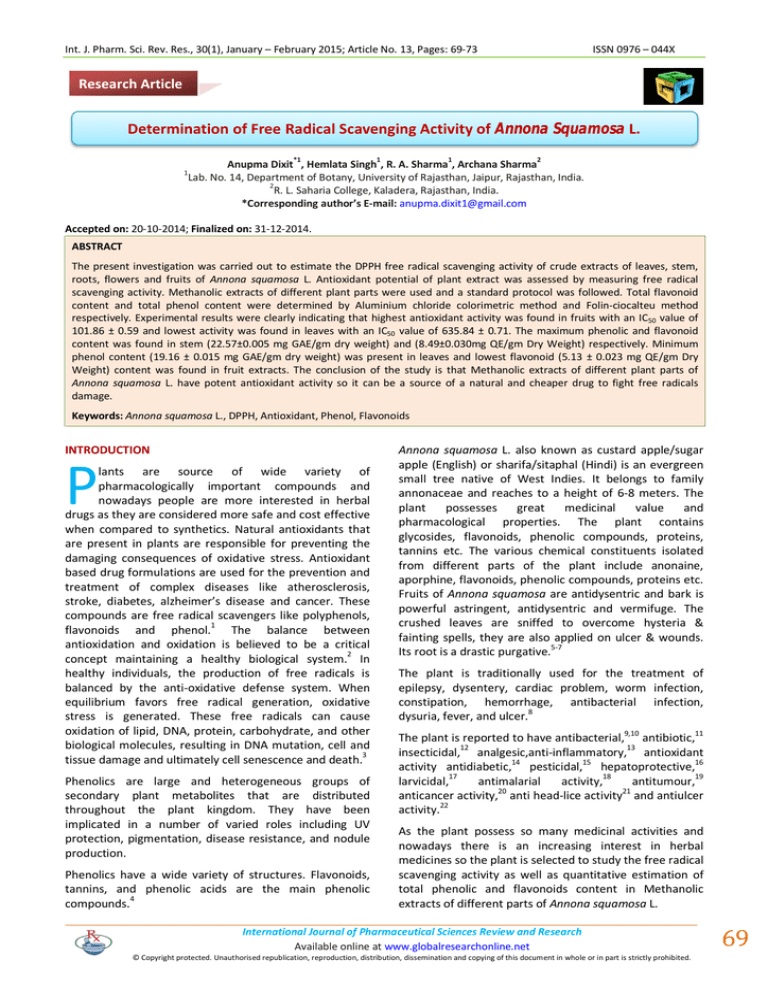
Int. J. Pharm. Sci. Rev. Res., 30(1), January – February 2015; Article No. 13, Pages: 69-73 ISSN 0976 – 044X Research Article Determination of Free Radical Scavenging Activity of Annona Squamosa L. *1 1 1 1 2 Anupma Dixit , Hemlata Singh , R. A. Sharma , Archana Sharma Lab. No. 14, Department of Botany, University of Rajasthan, Jaipur, Rajasthan, India. 2 R. L. Saharia College, Kaladera, Rajasthan, India. *Corresponding author’s E-mail: anupma.dixit1@gmail.com Accepted on: 20-10-2014; Finalized on: 31-12-2014. ABSTRACT The present investigation was carried out to estimate the DPPH free radical scavenging activity of crude extracts of leaves, stem, roots, flowers and fruits of Annona squamosa L. Antioxidant potential of plant extract was assessed by measuring free radical scavenging activity. Methanolic extracts of different plant parts were used and a standard protocol was followed. Total flavonoid content and total phenol content were determined by Aluminium chloride colorimetric method and Folin-ciocalteu method respectively. Experimental results were clearly indicating that highest antioxidant activity was found in fruits with an IC50 value of 101.86 ± 0.59 and lowest activity was found in leaves with an IC50 value of 635.84 ± 0.71. The maximum phenolic and flavonoid content was found in stem (22.57±0.005 mg GAE/gm dry weight) and (8.49±0.030mg QE/gm Dry Weight) respectively. Minimum phenol content (19.16 ± 0.015 mg GAE/gm dry weight) was present in leaves and lowest flavonoid (5.13 ± 0.023 mg QE/gm Dry Weight) content was found in fruit extracts. The conclusion of the study is that Methanolic extracts of different plant parts of Annona squamosa L. have potent antioxidant activity so it can be a source of a natural and cheaper drug to fight free radicals damage. Keywords: Annona squamosa L., DPPH, Antioxidant, Phenol, Flavonoids INTRODUCTION P lants are source of wide variety of pharmacologically important compounds and nowadays people are more interested in herbal drugs as they are considered more safe and cost effective when compared to synthetics. Natural antioxidants that are present in plants are responsible for preventing the damaging consequences of oxidative stress. Antioxidant based drug formulations are used for the prevention and treatment of complex diseases like atherosclerosis, stroke, diabetes, alzheimer’s disease and cancer. These compounds are free radical scavengers like polyphenols, 1 flavonoids and phenol. The balance between antioxidation and oxidation is believed to be a critical 2 concept maintaining a healthy biological system. In healthy individuals, the production of free radicals is balanced by the anti-oxidative defense system. When equilibrium favors free radical generation, oxidative stress is generated. These free radicals can cause oxidation of lipid, DNA, protein, carbohydrate, and other biological molecules, resulting in DNA mutation, cell and 3 tissue damage and ultimately cell senescence and death. Phenolics are large and heterogeneous groups of secondary plant metabolites that are distributed throughout the plant kingdom. They have been implicated in a number of varied roles including UV protection, pigmentation, disease resistance, and nodule production. Phenolics have a wide variety of structures. Flavonoids, tannins, and phenolic acids are the main phenolic 4 compounds. Annona squamosa L. also known as custard apple/sugar apple (English) or sharifa/sitaphal (Hindi) is an evergreen small tree native of West Indies. It belongs to family annonaceae and reaches to a height of 6-8 meters. The plant possesses great medicinal value and pharmacological properties. The plant contains glycosides, flavonoids, phenolic compounds, proteins, tannins etc. The various chemical constituents isolated from different parts of the plant include anonaine, aporphine, flavonoids, phenolic compounds, proteins etc. Fruits of Annona squamosa are antidysentric and bark is powerful astringent, antidysentric and vermifuge. The crushed leaves are sniffed to overcome hysteria & fainting spells, they are also applied on ulcer & wounds. 5-7 Its root is a drastic purgative. The plant is traditionally used for the treatment of epilepsy, dysentery, cardiac problem, worm infection, constipation, hemorrhage, antibacterial infection, dysuria, fever, and ulcer.8 The plant is reported to have antibacterial,9,10 antibiotic,11 insecticidal,12 analgesic,anti-inflammatory,13 antioxidant 14 15 16 activity antidiabetic, pesticidal, hepatoprotective, 17 18 19 larvicidal, antimalarial activity, antitumour, 20 21 anticancer activity, anti head-lice activity and antiulcer 22 activity. As the plant possess so many medicinal activities and nowadays there is an increasing interest in herbal medicines so the plant is selected to study the free radical scavenging activity as well as quantitative estimation of total phenolic and flavonoids content in Methanolic extracts of different parts of Annona squamosa L. International Journal of Pharmaceutical Sciences Review and Research Available online at www.globalresearchonline.net © Copyright protected. Unauthorised republication, reproduction, distribution, dissemination and copying of this document in whole or in part is strictly prohibited. 69 © Copyright pro Int. J. Pharm. Sci. Rev. Res., 30(1), January – February 2015; Article No. 13, Pages: 69-73 ISSN 0976 – 044X MATERIAL AND METHODS Determination of Total Flavonoids Content (TFC) Plant Material Aluminium chloride colorimetric method was used to determine the total flavonoid content of plant extracts.24 To estimate flavonoid content of plant extract 1 ml of extract was taken and 3 ml methanol added to it. After that 0.2 ml of aluminium chloride (10%), 0.2 ml potassium acetate (1M) and 5.6 ml distilled water were added. Optical densities were measured at 415 nm against a blank. Serial dilution (25, 50,100,200 µg/ml) of Methanolic solution of quercetin were used to prepare a standard curve. Plant material viz, leaves, stem, root, flowers and fruits of Annona squamosa L. were collected from S.B.N. College Campus, Jaipur during October- November 2013. Voucher specimen of the plant samples (RUBL21105) were deposited in herbarium Department of Botany, University of Rajasthan, Jaipur. All plant parts were washed with running tap water and then dried under shade .Then an electric blender was used to grind this material to fine powder. Chemicals and Reagents 2, 2-Diphenyl-1-Picryl Hydrazyl (DPPH) and Quercetin were procured from Sigma Chemical Co. (St., Louis, USA)., Ascorbic acid, Folin Ciocalteu’s reagent, Phenol, Gallic acid, anhydrous Sodium carbonate, Aluminum chloride, and Potassium acetate and methanol. All other chemicals mentioned were obtained from Thermo Fisher Scientific India Pvt. Ltd Powai, Mumbai and Sisco Research Laboratories (SRL) PVT. Ltd. (Mumbai, India). All chemicals used were of analytical grade. The total flavonoid content of extracts was calculated using following formula and were expressed in quercetin equivalent (mg of QE/gdw) = × T = total flavonoid content mg QE /g dry weight of plant extract C = concentration of quercetin mg/ ml V = volume of extract in ml Preparation of Plant Extract M = plant extract weight in grams The dried powder of different parts of Annona squamosa L. (10 grams each) was soxhlet extracted with methanol for 24 hours. DPPH Radical Scavenging Activity Measurement The extracts were collected by using whatman filter paper no 1 for filtration and filtrates were concentrated to dryness through incubation at room temperature. The extract was preserved for further use in different experiments. Determination of Total Phenol Content (TPC) The total phenol concentration was measured using the Folin-Ciocalteu method.23 To 1 ml of plant extract; 5 ml Folin-Ciocalteu reagent (diluted 10 fold) and 4 ml sodium carbonate solution (0.7 M) were added. Experiment was conducted in triplicates. Calibration curve was prepared using 1 ml Methanolic solution of Gallic acid (.0100.4mg/ml) following above mentioned procedure. After incubating one hour at room temperature, absorbance was measured at 765 nm using spectrophotometer against a reagent blank. Total phenol content of extracts was expressed as Gallic acid equivalents (mg of GAE/ g sample). Following formula was used to calculate the total phenol content. = Free radical scavenging activity of plant extracts was determined by spectrophotometric method.25 To 1 ml Methanolic solution of (0.3) mM DPPH, 1 ml test extracts/standard of different concentrations were added. After incubating for 30 minutes at room temperature in a dark chamber, the absorbance was measured at 517nm against a control. The percentage scavenging activity was expressed as percentage inhibition of DPPH free radical by the sample and was calculated by using the following expression: = − × 100 Statistical Analysis Results of the experiments are expressed as mean ± S.E.M. All experiments were done in triplicates. IC50 Values, which is the concentration of the sample that is required to scavenge 50% of DPPH free radicals, were calculated by linear regression curve. Microsoft excel was used for statistical analysis. RESULTS AND DISCUSSION Total Phenol Content (TPC) × T = total phenol content, mg GAE /gram dry weight of extract C = concentration of Gallic acid mg/ml V = volume of plant extract in ml M = Methanolic plant extract weight in grams Phenols are very well known for their free radical scavenging activity and antioxidant potential. The antioxidant activity of these plant extracts can be correlated with their total phenol content. The antioxidant activity of phenolics is mainly due to their redox properties, which can play an important role in adsorbing and neutralizing free radicals, quenching 26 singlet and triplet oxygen or decomposing peroxides. International Journal of Pharmaceutical Sciences Review and Research Available online at www.globalresearchonline.net © Copyright protected. Unauthorised republication, reproduction, distribution, dissemination and copying of this document in whole or in part is strictly prohibited. 70 © Copyright pro Int. J. Pharm. Sci. Rev. Res., 30(1), January – February 2015; Article No. 13, Pages: 69-73 When crude extracts of different plant parts were analyzed for their total phenol content it was found that maximum content of phenols was present in stem’s extracts (22.57 ± 0.005 mg GAE/gm dry weight) and leaves possess minimum phenolic content. (19.16 ± 0.015 mg GAE/gm Dry Weight) Folin-Ciocalteu method was used to estimate phenol content in different plant extracts. Results are expressed as gallic acid equivalents/gram dry weight of plant extract. ISSN 0976 – 044X colour and change in to yellow colour. This shows the potential antioxidant activity of substance used.27 Methanolic crude extracts of different plant parts were used to estimate their free radical scavenging activity. Results of the DPPH assay finds that highest antioxidant activity was found in fruits with an IC50 value of 101.86 ± 0.59 and lowest activity was found in leaves with an IC50 value of 635.84 ± 0.71. All experimental results of DPPH assay of crude extracts of different plant parts of Annona squamosa L. are shown in Table 2. Table 2: IC50 Values of different plant parts of Annona squamosa L. Total Flavonoid Content (TFC) Flavonoids have the ability to reduce free radical damage and have potential health benefits in diseases caused by oxidative stress. The lowest content of flavonoids was found in fruits (5.13 ± 0.023mg QE/gm Dry Weight) and crude extracts of stem were having maximum flavonoids content with a value of 8.49 ± 0.030mg QE/gm dry weight. Aluminium chloride colorimetric method was used to estimate total flavonoid content. Experimental results are given in Table 1 and a comparative analysis of total phenol and flavonoid content of crude extracts of Annona squamosa L. is given in Figure 1. Table 1: Total phenol and flavonoids content in different crude extracts of Annona squamosa L. Plant Parts Total phenol content mg GAE/g dry weight of extract Total flavonoid content mg QE/ g dry weight of extract Leaf 19.16 ± 0.015 7.26 ± 0.015 Stem 22.57 ± 0.005 8.49 ± 0.030 Root 21.42 ± 0.030 6.75 ± 0.020 Fruit 22.17 ± 0.026 5.13 ± 0.023 Plant Parts IC50 values (µg/ml) Root 305.66 ± 1.28 Stem 416.66 ± 0.07 Fruit 101.86 ± 0.59 Flower 193.44 ± 0.27 Leaf 635.84 ± 0.71 Ascorbic acid 16.33 ± 0.32 Figure: 2-6 are graphical representation of DPPH radical scavenging activity of different plant parts of Annona squamosa L. Figure 2: DPPH Radical scavenging assay of stem’s Methanolic extract of Annona squamosa L. Figure 1: Total phenol and flavonoid content of crude extract of Annona squamosa L. DPPH Radical Scavenging Activity Antioxidant potential and free radical scavenging activity of natural products is an area of growing interest these days. A very popular method to find out antioxidant potential of plant extracts is based upon the use of the stable free radical diphenyl picryl hydrazyl (DPPH). When a solution of DPPH is mixed with that of a substance that can donate a hydrogen atom, then this gives rise to the reduced form with the loss of this violet Figure 3: DPPH Radical scavenging assay of Methanolic extract of Annona squamosa L. flowers International Journal of Pharmaceutical Sciences Review and Research Available online at www.globalresearchonline.net © Copyright protected. Unauthorised republication, reproduction, distribution, dissemination and copying of this document in whole or in part is strictly prohibited. 71 © Copyright pro Int. J. Pharm. Sci. Rev. Res., 30(1), January – February 2015; Article No. 13, Pages: 69-73 ISSN 0976 – 044X REFERENCES 1. Khalaf NA, Shakya AK, Al-othman A, El-agbar Z, Farah H, Antioxidant Activity of Some Common Plants, Turk J Biol, 32, 2008, 51-55. 2. Katalinic V, Milos M, Kulisic T, Jukic M, Screening of 70 medicinal plant extracts for antioxidant capacity and total phenols, Food Chemistry, 94, 2006, 550–557. 3. Shyura LF, Tsunga JH, Chenb JH, Chiua CY, Loa CP, Antioxidant Properties of Extracts from Medicinal Plants Popularly Used in Taiwan, International Journal of Applied Science and Engineering, 3(3), 2005, 195-202. 4. Maestri DM, Nepote V, Lamarque AL, Zygadlo JA, Natural products as antioxidants, Phytochemistry: Advances in Research, 2006, 105-135. 5. Tomar RS, Sisodia SS, Antidiabetic activity of Annona squamosa L. in experimental induced diabetic rats, International Journal of Pharmaceutical & Biological Archives, 3(6), 2012, 1492-1495. 6. Pandey N, Barve D, Antioxidant Activity of Ethanolic Extract of Annona squamosa Linn Bark, International Journal of Research in Pharmaceutical and Biomedical Sciences, 2(4), 2011, 1692-1697. 7. Pandey N, Barve D, Phytochemical and Pharmacological Review on Annona squamosa Linn, International Journal of Research in Pharmaceutical and Biomedical Sciences, 2(4), 2011, 1404-1412. 8. Vidyasagar GM, Singh SK, A comparative antimicrobial activity of Methanolic root, leaf, seed cotyledon extracts of Annona squamosa L., International Journal of Pharmacy and Pharmaceutical Sciences, 4, 2012, 289-292. 9. Aher PS, Shinde YS, Chavan PP, In vitro evaluation of antibacterial potential of Annona squamosa l. Against pathogenic bacteria, International journal of pharmaceutical sciences and research, 3(5), 2012, 14571460. Figure 4: DPPH Radical scavenging assay of Methanolic extract of Annona squamosa L. leaves Figure 5: DPPH Radical scavenging assay of Methanolic extract of Annona squamosa L. fruits 10. Aamir J, Kumari A, Khan MN, Medam SK, Evaluation of the Combinational Antimicrobial Effect of Annona Squamosa and Phoenix Dactylifera Seeds. Methanolic Extract on Standard Microbial Strains, International Research Journal of Biological Sciences, 2(5), 2013, 68-73. Figure 6: DPPH Radical scavenging assay of Methanolic extract of Annona squamosa L. roots CONCLUSION From this study we find that a good amount of phenol and flavonoids are present in different crude extracts of Annona squamosa L. The extracts when tested for their free radical scavenging activity were found to have significant antioxidant potential. This activity is due to their higher phenol and flavonoids content. Hence the plant extracts are good source for development of natural antioxidant medicines for diseases involving free radicals. 11. Souza HHF, Fernandes CN, Tintino SR, Morais-Braga MFB, Araújo AC, Coutinho HDM, Menezes IRA, Kerntopf MR, Phytochemical composition, antibacterial and modulatory of antibiotic activity of the extract and fractions from Annona squamosa L., Ethnobiology and Conservation, 2(9), 2013, 1-8. 12. Seffrin RDC, Shikano I, Akhtar Y, Isman MB, Effects of crude seed extracts of Annona atemoya and Annona squamosa L. against the cabbage looper, Trichoplusia ni in the laboratory and greenhouse, Crop Protection, 29(1), 2010, 20-24. 13. Chavan MJ, Wakte PS, Shinde DB. Analgesic and anti inflammatory activity of Caryophyllene oxide from Annona squamosa L. bark, Phytomedicine, 17(2), 2010, 149-151. 14. Kaleem M, Asif M, Ahmed QU, Bano B, Antidiabetic and antioxidant activity of Annona squamosa extract in International Journal of Pharmaceutical Sciences Review and Research Available online at www.globalresearchonline.net © Copyright protected. Unauthorised republication, reproduction, distribution, dissemination and copying of this document in whole or in part is strictly prohibited. 72 © Copyright pro Int. J. Pharm. Sci. Rev. Res., 30(1), January – February 2015; Article No. 13, Pages: 69-73 streptozotocin-induced diabetic rats, Singapore Med J, 47(8), 2006, 670-675. 15. Kotkar HM, Mendki PS, Sadan SV, Jha SR, Upasani SM, Maheshwari VL, Antimicrobial and pesticidal activity of partially purified flavonoids of Annona squamosa Pest Manag Sci, 58(1), 2002, 33–37. 16. Mohamed Saleem TS, Christina AJM, Chidambaranathan N, Ravi V, Gauthaman K, Hepatoprotective activity of Annona squamosa Linn. On experimental animal model, International Journal of Applied Research in Natural Products, 1(3), 2008, 1-7. ISSN 0976 – 044X 771. 21. Intaranongpai J, Chavasiri W, Gritsanapan W, Anti-head lice effect of Annona squamosa seeds, Southeast Asian Journal Trop Med Public Health, 37(3), 2006, 532-535. 22. Yadava DK, Singh N, Sharma R, Sahai M, Palit G, Maurya R, Anti-ulcer constituents of Annona squamosa Twigs. Fitoterapia, 82(4), 2011, 666-675. 23. McDonald S, Prenzler PD, Autolovich M, Robards K, Phenolic content and antioxidant activity of olive extracts, Food Chem, 73, 2001, 73-84. 17. Kaushik R, Saini P, Screening of some semi-arid region plants for larvicidal activity against Aedes aegypti mosquitoes, J Vector Borne Dis, 46, 2009, 244–246. 24. Chang C, Yang M, Wen H, Chern J, Estimation of total flavonoid content in propolis by two complementary colorimetric methods, J Food Drug Analy, 10, 2002, 178182. 18. Tylor J, Arnold W, Thomas J, Mansor SM. Antimalarial alkaloids isolated from Annona squamosa, Phytopharmacology, 1(3), 2011, 49-53. 25. Blois MS. Antioxidant determination by use of Stable free radicals, Nature, 29, 1958, 1199-1200. 19. Khar A, Antitumour activity of Annona squamosa seed extracts is through the generation of free radicals and induction of apoptosis, Indian Journal of Biochemistry & Biophysics, 41, 2004, 167-172. 26. Raghavendra M, Reddy M, Yadav PR, Raju S, Kumar IS, Comparative studies on the in vitro antioxidant properties of methanolic leafy extracts from six edible leafy vegetables of India, Asian Journal of Pharmaceutical and Clinical Research, 6(3), 2013, 96-99. 20. Liaw CC, Yang YL, Chen M, Chang FR, Chen SL, Wu SH, Wu YC, Mono-tetrahydrofuran annonaceous acetogenins from Annona squamosa as cytotoxic agent and calcium ion chelators, Journal of Natural Products, 71(5), 2008, 764- 27. Molyneux P, The use of the stable free radical diphenylpicrylhydrazyl (DPPH) for estimating antioxidant activity, Songklanakarin J Sci Technol, 26(2), 2004, 211-219. Source of Support: Nil, Conflict of Interest: None. International Journal of Pharmaceutical Sciences Review and Research Available online at www.globalresearchonline.net © Copyright protected. Unauthorised republication, reproduction, distribution, dissemination and copying of this document in whole or in part is strictly prohibited. 73 © Copyright pro

